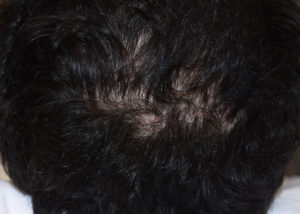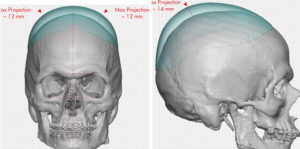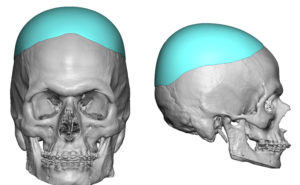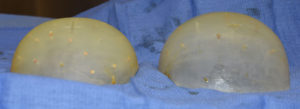Background: Various forms of skull augmentation have become a common procedure in my practice. From flatness on the back of the head, a narrow head width, the desire for greater skull height and shape to a more projecting forehead and/or brows, custom skull implants can more than adequately meet these needs with a safe and fairly predictable outcome.
Such skull implants are very powerful but their amount of augmentation possible its ultimately controlled by the stretch of the scalp. Because of some patient desires for results that exceed what the scalp will allow, the concept of a two-stage skull augmentation was developed. In the first stage a scalp tissue expander is placed which creates the subperiosteal pocket space needed for the placement of a large custom skull implant as the second stage.
With one and two stage custom skull augmentations, the patient must traditionally decide up front which direction they want to go based on their aesthetic head shape goals. If a patient knows that they really want a larger type result they may opt for the standard two stage approach upon front. But some patients who may be uncertain or for economic or logistical reasons go instead for the immediate placement of the implant. But what if one does so and then they decide later they want a larger skull augmentation?


Under general anesthesia, his existing coronal incision was re-opened and his skull implant exposed and removed. The difference in the height of the two implants could be seen when placed side by side. 
This is not the first time that I have performed a secondary larger skull implant to replace an existing one. In each case, as this patient demonstrates, the first skull implant does act as an effective tissue expander. There is more stretch of the scalp to be had even though the initial implant has a capsule around it. This is a relevant observation for those patients who may ideally want a much larger skull implant but are limited at the time for a variety of reasons to a one-stage skull augmentation approach.
Highlights:
- Like any other form of body enhancement patients may want to increase the size of their augmentation later.
- A larger skull implant can be placed secondarily after a first one which acts as a ‘first stage’ tissue expander.
- The scalp expansion effect of a first skull implant generally allows for a 50% or greater in volume for the second skull implant.
Dr. Barry Eppley
Indianapolis, Indiana




